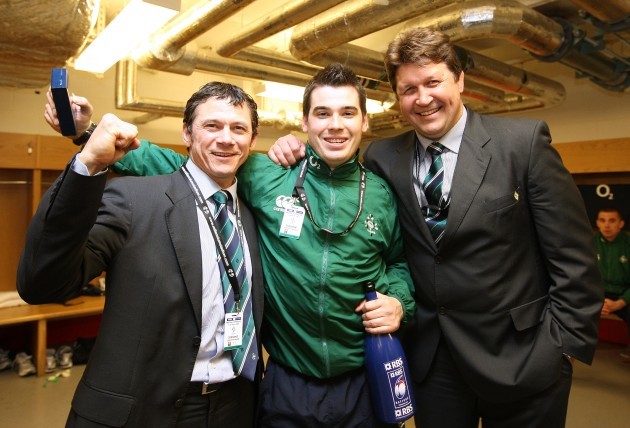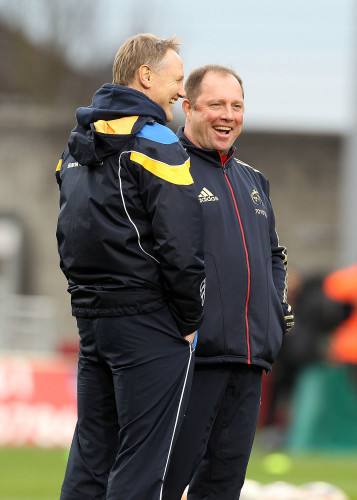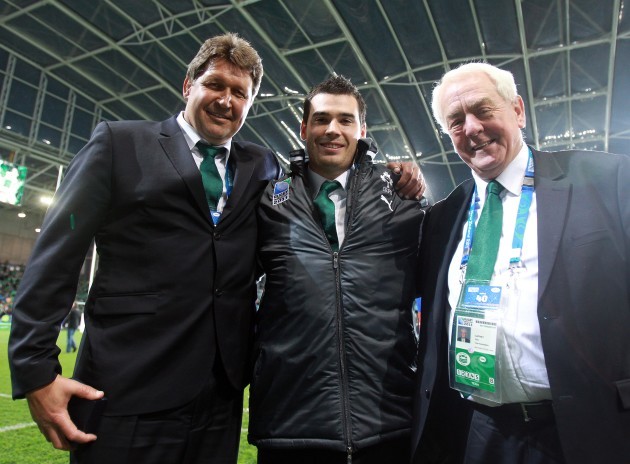AS LEARNING EXPERIENCES go, it doesn’t get much better than working with rugby wise men such as Joe Schmidt, Les Kiss, Declan Kidney, Kurt McQuilkin, Mervyn Murphy, Gert Smal, and Tony McGahan.
Eoin Toolan has done so and is now putting the valuable knowledge he has amassed into his duties as head performance analyst of the Melbourne Rebels.
The former Greystones clubman, who was a Grand Slam winner with Ireland as an assistant analyst, works alongside ex-Munster head coach Tony McGahan in Melbourne.
Since arriving in late 2013, Toolan has essentially built an analysis department from scratch and is now a key cog in educating a youthful Rebels squad.
“I get on really well with Tony,” says Toolan when we meet in Dublin after the conclusion of the 2016 Super Rugby campaign, in which the Rebels finished third in the Australian conference.
“He’s focused on trying to develop a young group of players. The average age is around 23 or 24. Tony is a really driven guy and drives those standards very hard for both players and coaches.”
A graduate of Media and Communications in Griffith College and a former fullback, Toolan began working in analysis in 2007, when Kurt McQuilkin was coaching at Greystones alongside a role in the IRFU’s High Performance Unit.
McQuilkin needed help on the computer side of the IRFU job, meaning Toolan was brought on board part-time to cut game tape, compile clips onto DVDs and send statistical reports to the four provincial academy managers.
The analysis centred on tracking the AIL or U20 appearances of a group of 15 promising players, including Johnny Sexton, Felix Jones, Sean O’Brien, Ian Keatley and Cian Healy.
“I was still playing in Greystones,” says Toolan. “I could have been watching an AIL game with O’Brien or Keatley involved earlier in the week and then I’d end up playing against them on the pitch, which was gas!”
Toolan went on to work with the Leinster U20s, Ireland Schools, Ireland U20s and other representative teams. When the senior national team’s head analyst, Mervyn Murphy, realised in June 2008 that he needed a full-time assistant, he didn’t have to look too far.
Less than a year later, Toolan was part of the 2009 Grand Slam triumph.
“It was a great time to come in. You’re pinching yourself at times. You’re working with guys you would have looked up to, so it was a massive rush. To win the Six Nations straight off the bat was unreal.”
Toolan’s main duties involved filming training, cutting up games, and carrying out individual analysis with players. He was also tasked with putting together packages on Ireland’s opposition, compilations of how they attacked from scrums or lineouts, for example.
Outside of national camps, himself and Murphy tracked a group of around 45 players, analysing the components of their game – catch-pass, carry, breakdown, tackle – and providing the Ireland coaches with feedback each week.
Murphy has been with Ireland since 2001, remaining in-situ now, and Toolan says he was an invaluable guide.
“Merv’s been a massive influence on my career,” says Toolan. “He’s got a really good eye for detail and his understanding of rugby is excellent. He’s so respected by all the players in there.
He’d been on his own throughout his career with Ireland before I came in. Back at the start he was making video tapes after games for all the players and coaches, on VCR.”
Toolan was a sponge in terms of learning from the coaches during his Ireland years.
Declan Kidney took charge of the national team at the same time as Toolan came on board. He “empowered his coaches,” explains Toolan. Les Kiss and Gert Smal performed the technical coaching, but Kidney did “an awful lot of off-the-ball stuff with players – work rate off the ball, demeanour, things like that.”
Kiss’ defensive intellect was influential on Toolan, while he laughs when recalling the “pages and pages and pages of lineouts” that South African forwards coach Smal always had nearby. Alan Gaffney was highly knowledgable on backs and attack play, becoming a good friend of Toolan’s.
The post-Grand Slam years weren’t as successful for Ireland as they transitioned, but Toolan was still involved when Joe Schmidt took over in 2013. Immediately, there was a shift.
“How he sees the game is different to anyone I’ve worked with,” says Toolan. “His attention to detail on the individual is huge; what he demands of the ball carrier, what he demands from his guys in the breakdown.
“It was very different to what I’d seen before and he had a very clear idea of what he wanted from his players. Players had a very clear idea of what his expectations were. He really took over the opposition analysis. He’s renowned for his power plays; he spots weaknesses in the opposition defence and is able to exploit them more often than not.
“100%, you’re stepping up. What he demanded from analysts was huge. It also maybe placed a higher importance on what you were producing.”
Toolan was happy in his position with Ireland and hadn’t been pondering leaving, but McGahan made an approach on the recommendation of Gaffney, the ex-Ireland backs coach.
A move to Super Rugby and the opportunity to drive his own programme was impossible for Toolan to resist and he made the shift to Melbourne along with his wife, Sinead, ahead of the 2014 season.
In terms of analysis, Toolan discovered that Australia was some distance behind Ireland. The Rebels had been using PC-based software and had previously done very little in the way of opposition or individual analysis.
However, with a big turnaround in playing staff for 2014 and the blooding of young, information-hungry players, the Rebels were ripe for a culture shift.
“There was a new generation of young guys who had no real previous exposure to analysis,” says Toolan. “It takes time to educate them and get them to understand what they need to see when they look at footage.”
Toolan introduced the gold-standard Sportscode analysis software on Macs and launched a genuine analysis programme at the Melbourne franchise. By the end of 2014, he had an assistant in John Batina, while analysis was a vital part of the day-to-day schedule.
Toolan has since utilised an app called GamePlan to allow the Rebels’ players to carry out analysis remotely on their iPads and phones, giving them access to everything they see in Sportscode on the computers at the training centre.
“A big challenge for us, because our programme was big, was getting players to watch footage away from the office,” says Toolan.
“We never needed anything like that with Ireland, because when you’re in camp you’ve got a room set-up with your computers for analysis. When you’re in a club environment, players go home at the end of the day, so you’re trying to get the information to them in another format. The engagement has been really good.”
Intriguingly, Toolan says that the general analysis culture in Australia and New Zealand had lagged behind the likes of Ireland for many years. Indeed, Irish players were seen as leaders in this area.
“I remember hearing a comment from Rhys Long, who was the Lions’ analyst in 2009, and he was blown away by the Irish guys’ ability to analyse and use the software, compared to the Welsh and English. He said they were light years ahead.
“Since I’ve come into Melbourne, the Wallabies have gone to Sportscode and I think the Queensland Reds have too. Michael Chieka obviously saw there was a need to improve what the Wallabies are doing. New Zealand went to Sportscode in 2012 and there’s been a huge increase and onus on analysis there as well.”
Toolan has three major contributions during the week before the Rebels’ games.
On Tuesdays, he presents on where and how the opposition is likely to attack the Rebels. Concisely pinpointing what teams like the Highlanders – who have a vast menu of strike plays – are going to bring can be a test, but Toolan relishes it.
His second key meeting brings the focus onto two or three individual opposition players, either picking out weaknesses that can be targeted or highlighting attributes that the Rebels must negate.
Finally, his third presentation is on the referee for the forthcoming fixture. Toolan says this is an important area of analysis.
“The Rebels were top three in terms of poorest discipline before we came to the club. We place a lot of emphasis on referee analysis, looking at key traits, trends, where they give most of their penalties.
“We’ve gone from having one of the worst to one of the best disciplines in the last two years.”
Game day is a relentlessly busy one for Toolan, who has had to build a system of his own in this regard too.
“Super Rugby is miles behind in terms of provision for analysis,” says Toolan, explaining that he has designed his own infrastructure to allow high-quality live analysis of the Rebels’ games.
Whereas Super Rugby provides just a single-view stream of matches into the coaches’ box, Toolan has built a system at the Rebels’ AAMI Park that now provides McGahan and his staff with four HD camera views of the games onto their iPads.
Toolan is also in the coaches’ box during games, breaking down footage for McGahan and co. immediately after it happens, allowing them to instantly review and also to download clips onto the iPads if they need to share vision with players at half time.
Naturally, the review phase of the analyst’s job is also huge.
“In Melbourne, we would have six or seven key performance indicators [KPIs] that we look hard at,” says Toolan. “We’d look at it from a ball carry point of view and definitely the breakdown. The emphasis on breakdown in Super Rugby is just enormous, we spend a lot of time on that.
“We’d have KPIs around speed of ball, that’s a big thing for us. Then we’d have what we call red-zone resistance, so opposition entries into our 22, how often they come away with points. And we look at green zone efficiency too, us in the opposition 22.
“There are six or seven we’d look at hard, but then Tony isn’t a big numbers person either. He’s more about wanting to educate. That’s a big remit for me and all the coaches, because the players are so young.”
Toolan calls himself “a visual person,” which is certainly a useful trait for his role. While much of the Rebels’ performance data is initially presented in statistical form, there is always a layer of video behind it.
Toolan demonstrates by highlighting the win percentage of the Rebels’ scrum in one fixture. Behind the initial figure are a number of layers – “from 40% of those scrums, we went to the backs, then 50% of those launches came in our ‘Amber D’ zone of the pitch.”
Behind those figures lies the video footage of the specific incidents in question, making it easily understandable and digestible for players and coaches.
In an individual sense, it allows players to drill into how many of their tackles or carries were dominant, for example, with each and every grading backed up by the ready-to-view video clips that facilitate learning and coaching.
“We’re all about education through footage, rather than numbers,” explains Toolan.
The Rebels analyst is currently in the midst of “best practice” study of the Rugby Championship, a part of the job he greatly enjoys.
“It’s important to look at what the best teams are doing,” he explains. “We did a best practice project with the players for the World Cup last year.
“We split them into coaching groups and they all got a team each, and had to provide us with a review of every game. They’d present to the other players on a Monday morning on what went well, what needed improving. Again, it’s just trying to educate them.”
Toolan formerly coached at St. Gerard’s College – his own school – and he has continued along that avenue in Australia by doing technical work with some of the Rebels’ players in-season, as well as running the ‘opposition’ attack on the pitch during training weeks.
Last year, he worked on the defence for the Melbourne Rising, who are involved in Australia’s National Rugby Championship.
He has also been joined in the Rebels’ set-up by fellow Irishmen Shane Lehane and Brian Whelan, who take care of the strength and conditioning, while former Leinster and Connacht prop Jamie Hagan is part of the playing staff.
The Rebels certainly have extensive room for growth, but Toolan is excited to be part of the project.
“I’m really enjoying it. I’m contracted for another year, and then I’ll take it from there. I’ve loved every minute of it.
“We’re so nomadic in the Rebels, we only signed our first two Victorians this season and a third in off-season, so nearly everyone’s from out of town. It’s good because it brings you closer together.
“It’s great to be part of something that we have built from the ground up, so you want to be there when, hopefully, the success comes.”
The42 is on Snapchat! Tap the button below on your phone to add!





